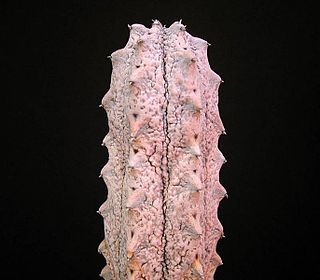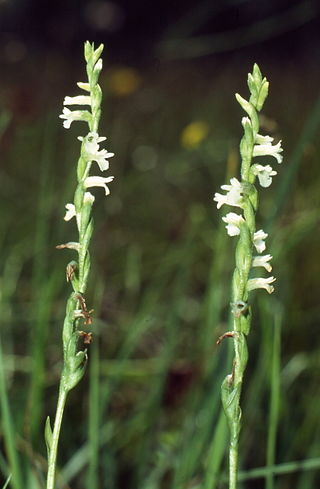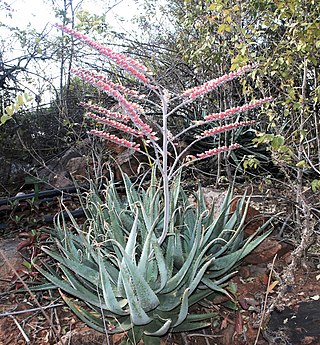
William Aiton was a Scottish botanist.

Aichryson is a genus of about 15 species of succulent, subtropical plants, mostly native to the Canary Islands, with a few in the Azores, Madeira and Morocco.

Acanthocalycium is a genus of cactus consisting of several species from Argentina, Bolivia, Brazil, Paraguay and Uruguay. The taxon name comes from Greek akantha and kalyx, which refers to the spines on the floral tubes.

Aizoanthemum is a small genus of plant in the family Aizoaceae, native to Namibia and Angola. It has only 5 species. Before being given their own genus, these species were considered a subgenus of Aizoon. The genus name comes from the Greek "anthemon" (flowering) and for the similarity to the genus Aizoon.

Rhodiola is a genus of perennial plants in the family Crassulaceae that resemble Sedum and other members of the family. Like sedums, Rhodiola species are often called stonecrops. Some authors merge Rhodiola into Sedum.
Durio acutifolius is a species of durian tree in the family Malvaceae. It is endemic to Borneo. The specific epithet, acutifolius, meaning "thorny leaves", is derived from Latin acutus, and -folius (-leaved).

Euphorbia abdelkuri is a species of plant in the family Euphorbiaceae. It is endemic to Abd al Kuri, an island south of Yemen. Its natural habitat is rocky areas. The Latex of the plant is toxic.

Cochemiea guelzowiana is a species of plant in the family Cactaceae. The species epithet guelzowiana honors the German cactus collector Robert Gülzow of Berlín.

Spiranthes aestivalis, commonly called the summer lady's-tresses, is a species of orchid found in western Europe, Turkey, Russia, and North Africa. The specific epithet, aestivalis, is derived from Latin and means "pertaining to the summer".

Heuchera abramsii is a rare species of flowering plant in the saxifrage family known by the common names San Gabriel alumroot and Abrams' alumroot.

Allium abramsii is a species of wild onion known by the common name Abrams' onion.

Gastrochilus acutifolius is a species of orchid found in Assam (India), eastern Himalayas, Nepal, Myanmar and Vietnam. The specific epithet, acutifolius, meaning "thorny leaves", is derived from Latin acutus, and -folius (-leaved), and refers to the characteristic shape of the leaves.
Afronemacheilus abyssinicus is a species of stone loach endemic to Ethiopia. It is known from the Blue Nile at its outlet from Tana Lake, with records from the Baro River. Originally the only species in its genus, in 2013 A. kaffa was described based on the Omo population, formerly included in A. abyssinicus.
Lactifluus acicularis is a species of milk-cap fungus in the family Russulaceae. Described as new to science in 2010, the species is found in Chiang Mai Province of northern Thailand, where it grows in rainforests that are dominated by Castanopsis armata, Dipterocarpus sp. and Lithocarpus. The specific epithet, acicularis, is derived from Latin and means "needle-shaped".
Kalanchoe adelae is a succulent plant that grows in the Comoros. It was discovered by French botanist Raymond Hamet. It is named after Madame Adele Le Chartier, an acquaintance of Hamet.

Aloe globuligemma, commonly known as the witchdoctor's aloe, is a species of flowering plant in the family Asphodelaceae. It is native to southern Africa where it occurs in semi-desert and dry bushland. It is an evergreen, succulent, perennial plant. The plant forms large, dense clumps. It is harvested from the wild for local medicinal use.

Robert Stephen Adamson was a British botanist. He was a fellow of Linnean Society, the British Ecological Society and the Royal Society of South Africa and its President in 1946-1948.
Fimbristylis aestivalis commonly known as summer fimbry, is a sedge of the family Cyperaceae that is native to Australia. The specific epithet, aestivalis, is derived from Latin and means "pertaining to the summer".

Carex aestivalis, the summer sedge, is a species of Carex native to North America. The specific epithet, aestivalis, is derived from Latin and means "pertaining to the summer".

Dracaena arborescens, synonym Sansevieria arborescens, is a succulent plant native to Kenya and Tanzania.















